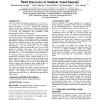799 search results - page 97 / 160 » Function Sequence Genetic Programming |
WABI
2009
Springer
14 years 3 months ago
2009
Springer
Background: Frameshift mutations in protein-coding DNA sequences produce a drastic change in the resulting protein sequence, which prevents classic protein alignment methods from ...
RECOMB
2003
Springer
14 years 9 months ago
2003
Springer
In [13] we reported the genome sequences of S. paradoxus, S. mikatae and S. bayanus and compared these three yeast species to their close relative, S. cerevisiae. Genome-wide comp...
BMCBI
2007
13 years 9 months ago
2007
Background: Genome-wide association studies of common diseases for common, low penetrance causal variants are underway. A proportion of these will alter protein sequences, the mos...
BMCBI
2007
13 years 9 months ago
2007
Background: MicroRNAs (miRNAs) are short, non-coding RNA molecules that are directly involved in post-transcriptional regulation of gene expression. The mature miRNA sequence bind...
WOTUG
2008
13 years 10 months ago
2008
Writing concurrent programs in languages that lack explicit support for concurrency can often be awkward and difficult. Haskell's monads provide a way to explicitly specify se...


